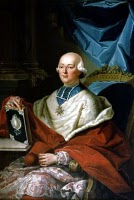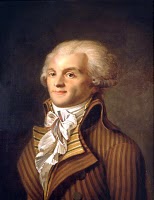The Diamond Necklace Affair was an 18th century sting. It took place in 1785, four years before the events that sparked the French Revolution. Though the Queen was a victim in the affair, it greatly damaged her already compromised reputation in the eyes of the French public. What happened was this:
 A lady claiming to be the Comtesse de Lamotte Valois convinced Cardinal de Rohan, who was desparate to win the Queen's favor, that Marie Antoinette desired a celebrated necklace consisting of 647 diamonds and numerous high quality gemstones, but that she lacked the funds to purchase it. Simultaneously, the Comtesse convinced the Crown Jeweler and designer of said necklace, M. Boehmer, that it would indeed be purchased by the Queen of France using Cardinal de Rohan as an intermediary.
A lady claiming to be the Comtesse de Lamotte Valois convinced Cardinal de Rohan, who was desparate to win the Queen's favor, that Marie Antoinette desired a celebrated necklace consisting of 647 diamonds and numerous high quality gemstones, but that she lacked the funds to purchase it. Simultaneously, the Comtesse convinced the Crown Jeweler and designer of said necklace, M. Boehmer, that it would indeed be purchased by the Queen of France using Cardinal de Rohan as an intermediary.
Boehmer was at first surprised by this news as he had been pestering the  Queen to buy his masterpiece for some time. Repeatedly, Marie Antoinette had refused, saying the 2 Million francs would better serve the Navy. She never actually wanted the garish, many-looped necklace. For one, she didn’t like the look of it. But also, she recognized the foolishness of indulging in such extravagance with the nation in financial turmoil. Unfortunately for Boehmer, no other European royal wanted the necklace either, so he was delighted to learn of the Queen's alleged change of heart. The Comtesse urged that the transaction go forward with the utmost discretion.
Queen to buy his masterpiece for some time. Repeatedly, Marie Antoinette had refused, saying the 2 Million francs would better serve the Navy. She never actually wanted the garish, many-looped necklace. For one, she didn’t like the look of it. But also, she recognized the foolishness of indulging in such extravagance with the nation in financial turmoil. Unfortunately for Boehmer, no other European royal wanted the necklace either, so he was delighted to learn of the Queen's alleged change of heart. The Comtesse urged that the transaction go forward with the utmost discretion.
Cardinal de Rohan, for his part, wanted nothing more than to be acknowledged by the Queen. She had not spoken to him, publicly or privately, for eight years. Recognizing this vulnerability, the Comtesse made him believe that the Queen secretly wanted the necklace. So de Rohan negotiated with Boehmer to purchase it for 1.6 Million francs in staged payments. With Comtesse's help, he delivered the necklace, as of yet unpaid, to the Queen under cover of night in a quiet corner of the Versailles gardens. He could therefore not understand why the Queen never wore the jewels nor why his status at Court remained unchanged.
 As it turns out, the letters received by de Rohan, presumably signed by Marie Antoinette, were forged, and the woman to whom the jewels were given was a prostitute bearing a remarkable resemblance to the Queen. She appeared before him in the shadows of the trees, elegantly veiled, and communicated only by the Queen's characteristic nod of the head. Boehmer was appeased as long as the scheduled payments of de Rohan continued. But when they stopped coming and the victims finally became aware of the hoax, the jewels were long gone. The necklace had been broken up and the gems sold off separately in London.
As it turns out, the letters received by de Rohan, presumably signed by Marie Antoinette, were forged, and the woman to whom the jewels were given was a prostitute bearing a remarkable resemblance to the Queen. She appeared before him in the shadows of the trees, elegantly veiled, and communicated only by the Queen's characteristic nod of the head. Boehmer was appeased as long as the scheduled payments of de Rohan continued. But when they stopped coming and the victims finally became aware of the hoax, the jewels were long gone. The necklace had been broken up and the gems sold off separately in London.
By the time the truth came out, the Queen was already embroiled in a public controversy with de Rohan, believing him a conspirator and a forger. The Paris pamphleteers went to town, expounding the fiction that the Queen was conniving, self-serving, and naïve. It was easier for her subjects to accept that she was a liar rather than the victim of a criminal conspiracy. She was guilty in their eyes because they wanted her to be.
The Diamond Necklace Affair provided fodder for the lack of trust the people felt toward their King and Queen as the events of 1789 began to unfold. Four years after the Affair...
...French peasants are spending an entire month's wages on bread alone.
...The King re-installs Jacques Necker, who is very popular with the people, as Finance Minister. Necker states that it is the duty of the French government to ensure that every citizen has enough bread and grain. The population is hopeful once again.
...Necker urges the King to convene the Estates General to help find a resolution to the country's financial dilemma. But the Third Estate are almost immediately locked out of the meeting!
...In their own meeting, he delegates of the Third Estate form the National Assembly, calling it “the true government of the People”. They vow to write France's first constitution.

...Third Estate delegate, Maximilien Robespierre, leads the charge for the nobility and aristocracy to start paying their fair share in taxes.
...July 9: the National Assembly turns itself into a Constituent National Assembly, giving itself the power to make laws.
...July 10: 30,000 Royal troops surround the city of Paris on the orders of the King.
...July 11: Louis XVI sacks the most popular man in his government – Jacques Necker - and has him spirited out of the country!
Only three more days to Quatorze Juillet. Stay tuned for daily updates as the hungry people grow ever more alarmed at the guns pointing at them!
Images:
Painting of Cardinal de Rohan, courtesy of Wikimedia Commons.
Boehmer's infamous diamond necklace. Print courtesy of Wikimedia Commons.
Drawing of Marie Antointte in the Versailles gardens by Élisabeth-Louise Vigée-Le Brun, c. 1783, courtesy of Wikimedia Commons. This is what the impersonator might have looked like to de Rohan.
Painting of Maximilien Robespierre, courtesy of Wikimedia Commons.Sources:
Fraser, Antonia. Marie Antoinette: The Journey. London: Phoenix Paperbacks, 2001.
Towle, Sarah B. Time Traveler Paris Tours: Beware Madame La Guillotine, in development.
 Saturday, September 5, 2009 at 3:37PM Tweet
Saturday, September 5, 2009 at 3:37PM Tweet 
 And like clockwork, in the 48-hour period coinciding with the last weekend in August, the highways and streets are clogged once again and tanned families are lined up in queues at the newly re-opened libraries (book stores) and papeteries (stationary stores) to buy the books and supplies required by their kids' schools, classes, and grades.
And like clockwork, in the 48-hour period coinciding with the last weekend in August, the highways and streets are clogged once again and tanned families are lined up in queues at the newly re-opened libraries (book stores) and papeteries (stationary stores) to buy the books and supplies required by their kids' schools, classes, and grades. 1 Comment | |
1 Comment | |  Email Article |
Email Article |  Print Article | tagged
Print Article | tagged  La Rentrée,
La Rentrée,  Paris in August | in
Paris in August | in  French Culture,
French Culture,  Paris Events |
Paris Events |  Permalink
Permalink 













 The Arc de Triomphe, or Triumphal Arch, stands at the center of Paris' famous Place de l'Étoile (or
The Arc de Triomphe, or Triumphal Arch, stands at the center of Paris' famous Place de l'Étoile (or 











